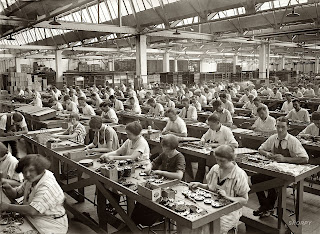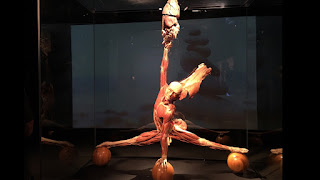Week 3: Art and Robots
Blog #3: Art and Robots
Much of this week’s material discusses the dehumanization of workers caused by industrialization. The idea is that as the workers become integrated in with the machinery, each performing one small task to contribute to the greater production goal, they are themselves forming one large machine. There is a negative implication here that they are giving up their humanity to earn a paycheck.
 |
| Factory workers in a production line. |
 |
| Damage and aging on Mona Lisa. |
Walter Benjamin took a different angle, arguing that the mass production and re-production of artwork deprives the reproductions of their uniqueness and changes their “aura.” He says that “even the most perfect reproduction of a work of art is lacking in one element: its
presence in time and space, its unique existence at the place where it happens to be.” While I don’t refute this point, I again question whether this is a bad thing. Mass reproduction of art makes that art more readily available to more people, and allows millions the opportunity to be inspired and affected by the art. The uniqueness of the original piece remains intact; its brushstrokes and acquired dings/dents will never be precisely replaced — even if they were, there is something inherently special about it being the original.
 |
| Robot from HBO's Westworld. |
Another topic that interested me this week was the difference between robots and cyborgs. Robots seem more vilified in our movies because its easier for us to imagine them having evil intentions. Cyborgs are at least part human, so it seems we think we’re able to relate to them better. Westworld, an HBO show, features robots that are so real you cannot tell the difference between them and natural humans. I think once technological gets to this point, it will be a great cause of uneasiness.
Works Cited
Benjamin, Walter. "The Work of Art in the Age of Mechanical Reproduction."
(1936). Print.
Gorman, Linda. “Hours Spent in Homemaking Have Changed Little This Century.” The National Bureau of Economic Research, www.nber.org/digest/oct08/w13985.html. Web.
“Mona Lisa Reveals a New Secret?” We Need Art, 15 Dec. 2010, weneedart.wordpress.com/2010/12/14/mona-lisa-reveals-a-new-secret/.
“Triple Forces of Modernity: Industrialism, Nationalism & Imperialism.” Concordia University-Wisconsin History, 5 Apr. 2017, cuwhist.wordpress.com/worldviews-hist-103/triple-forces-of-modernity-industrialism-nationalism-imperialism/.
Vesna, Victoria. Robotics Intro, Part 1, Part 2, Part 3. 2012. Video. Youtube. Web.
Watcher, Aether. “Scifi & Cyberpunk.” Pinterest, 22 Nov. 2016, www.pinterest.com/pin/330029478928421846/.



Tyler, Super intersting post, I like your inclusion of your own thought and feelings about how you believe there is dehumanisation in the production process. I do agree with you to some extent about the process being more efficient, but it is a shame that we lose the individual uniqueness of products, which is very ironic to me as in todays society we are always aiming to be "individual" in our own selves.
ReplyDeleteI also really like the way you think that there is dehumanization in the production process. I agree with the fact that you said that when art is mass reproduced it is readily available to the people it gives them the opportunity to be inspired and affected by the art. Love the Westworld picture too. Great post.
ReplyDelete